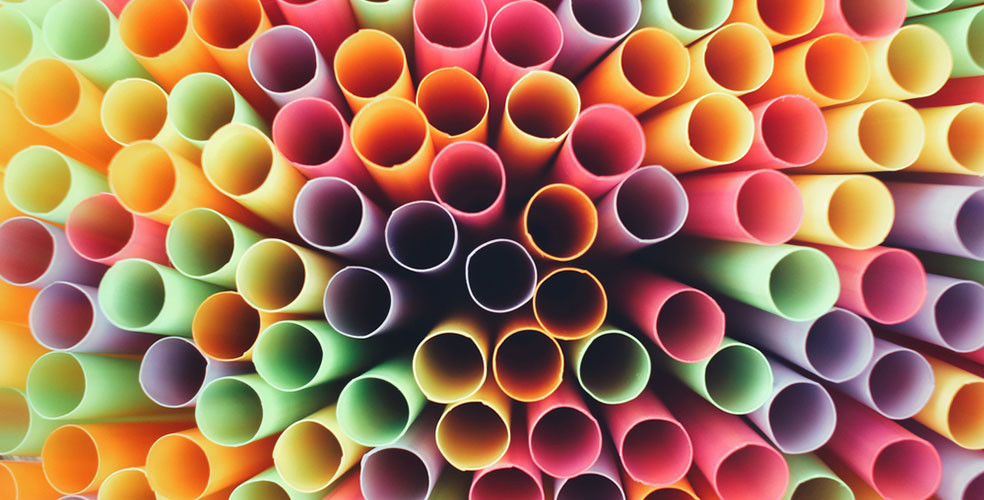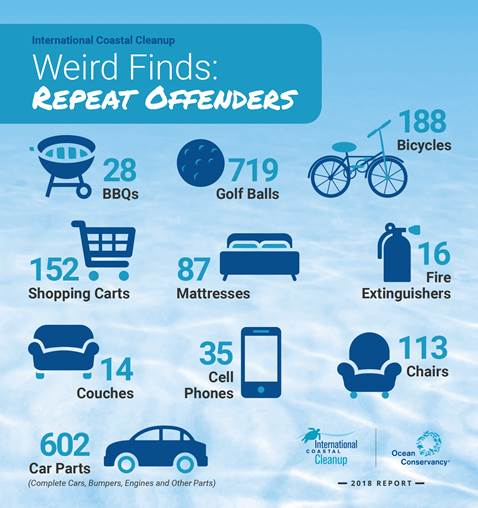As the world prepares for the start of beach season, the Washington, DC-based Ocean Conservancy has released a series of infographics depicting some of the weird items collected during its 2017 International Coastal Cleanup.
“You would be amazed at what volunteers find every year along beaches and waterways,” said Allison Schutes, associate director of Ocean Conservancy’s Trash Free Seas® program. “No matter where you are in the world, chances are you’ll see plastic bottles, bottle caps, straws, packaging… then you get items where you just have to wonder, ‘how did this get here?’”
First launched in 1986 on a beach in Texas, the International Coastal Cleanup mobilizes hundreds of thousands of volunteers in more than 100 countries all over the world to remove trash from local beaches, waterways, and parks. In addition to removing trash, volunteers contribute to the world’s largest database on marine debris by logging each trash item using data cards or in real-time using Ocean Conservancy’s Clean Swell app. Scientists, researchers, industry leaders and policymakers rely on Ocean Conservancy’s Ocean Trash Index to inform policy solutions to the growing marine debris crisis.
In years past, volunteers have recovered wedding dresses, washing machines, mattresses, and more. Notable items this year included three hot tubs, a unicycle, an entire car, a paper shredder, and a children’s slide, among others.

Did this vintage dress end up in the sea?

“There’s this idea that the ocean is so vast that it can just swallow up anything,” said Nicholas Mallos, director of Ocean Conservancy’s Trash Free Seas® program. “But the reality is that trash, specifically plastics, can have a serious impact on ocean health.”
Every year, millions of tons of trash—including an estimated 8 million metric tons of plastic waste—flow into the ocean, entangling wildlife, polluting beaches, and costing coastal municipalities hundreds of millions of taxpayer dollars. Cigarette butts, plastic beverage bottles, food wrappers, plastic bottle caps and plastic straws are among the most-commonly collected items. They are also among the most deadly to wildlife like seabirds and sea turtles. Plastics—which never fully biodegrade but rather break up into smaller and smaller pieces called microplastics—are of particular concern. Scientists predict that without concerted global action, there could be one ton of plastic for every three tons of fin fish in the ocean by 2025.

“By highlighting what gets left behind on shorelines and river banks, we inspire people to take action for trash-free seas and identify trash items for which innovative solutions are most needed,” said Mr. Mallos.
Global peeps can do their part by deciding to skip the straw, carrying reusable water bottles and signing up for a beach or waterway cleanup. Governments and businesses also play a critical role in trash free seas, by ensuring their products are recyclable and working to improve waste management and collection in countries where the flow of plastic and trash into the ocean is greatest.
Final numbers for the 2017 International Coastal Cleanup, including how many items and pounds of trash were collected, the number of volunteers, and other data will be available to the public in June 2018.

